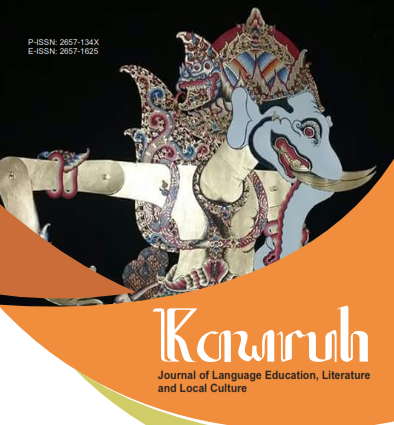Pembentukan Tubuh Perempuan Flores Dalam Tradisi Belis
DOI:
https://doi.org/10.32585/kawruh.v4i1.2245Kata Kunci:
Body shaping, belis, reproduction.Abstrak
The Belis tradition has been carried out by the people of Flores since hundreds of years ago. The belis tradition is part of the customary law of marriage in the cultural area of the Flores community. The term belis can be matched with the meaning of a dowry or an award given by a male family to a female family for proposing to a woman who will then enter into a male family clan or tribe. This study aims to reveal the formation of the female body in the Belis tradition of the Flores community. The research method uses descriptive qualitative method with content analysis techniques. The result is that the tradition of giving belis is maintained as a guarantor of human reproduction. The belis tradition which later became the great narrative of the Flores culture, made it a very strong cultural logocentrism. Belis tradition can be said as a reaction to the doctrine that women have reproductive tasks like machines. In conclusion, it can be said that this belis tradition is also the background of the Flores woman's body. The female body becomes a metaphor for mapping social life to reflect reality. In the end, it is increasingly recognized that perception of the body is more a sociocultural construct.Unduhan
Referensi
Adlin, Alfathri (ed). (2006). Resistensi Gaya Hidup: Teori dan Realitas. Yogyakarta: Jalasutra.
Anggraeni, Beding, Kalunga, Yuwono. (2003). Perempuan Sunda dan Belis. Sumba Timur: Bidang Penelitian dan Pengembangan BAPPEDA Pemerintah Kabupaten Sumba Timur.
Arndt, Paul. (2002). Hubungan Kemasyarakatan di Wilayah Sikka (terjemahan Paulus Sabon Nama). Flores: Puslit Candraditya.
Fakih, Mansour. (2013). Analisis Gender dan Transformasi Sosial. Yogyakarta: Pustaka Pelajar.
Foucault, Michel. (2017). Power/Knowledge (terjemahan Yudi Santosa). Yogyakarta: Narasi.
Hall, Calvin S. (2016). Naluri Kekuasaan Sigmund Freud. Yogyakarta: Narasi.
Harari, Yuval Noah. (2017). Sapiens: Sejarah Ringkas Umat Manusia dari Zaman Batu hingga Perkiraan Kepunahannya (terjemahan Yanto Musthofa). Tangerang Selatan: Alvabet.
_____. (2018). Homo Deus: Masa Depan Umat Manusia (terjemahan Yanto Musthofa). Tangerang Selatan: Alvabet.
Lash, Scott. (2004). Sosiologi Postmodern (terjemahan Gunawan Admiranto). Yogyakarta: Pustaka Pelajar.
Pareira, Mandalangi. (1988). Adat-Istiadat Sikka Krowe di Kabupaten Sikka. Flores:-
Peursen, van C.A. (1983). Tubuh, Jiwa, Roh (terjemahan K. Bertens). Jakarta: BPK Gunung Mulia.
Sutopo, H.B. (2002). Metodologi Penelitian Kualitatif. Surakarta: Universitas Sebelas Maret University Press.
Sutrisno, Mudji & Putranto, Hendar (ed). (2005). Teori-Teori Kebudayaan. Yogyakarta: Kanisius.
Unduhan
File Tambahan
Diterbitkan
Cara Mengutip
Terbitan
Bagian
Lisensi
Authors who publish with the Kawruh: Journal of Language Education, Literature and Local Culture agree to the following terms:
- Authors retain copyright and grant the journal the right of first publication with the work simultaneously licensed under a Creative Commons Attribution License (CC BY-SA 4.0) that allows others to share the work with an acknowledgment of the work's authorship and initial publication in this journal.
- Authors are able to enter into separate, additional contractual arrangements for the non-exclusive distribution of the journal's published version of the work (e.g., post it to an institutional repository or publish it in a book), with an acknowledgment of its initial publication in this journal.
- Authors are permitted and encouraged to post their work online (e.g., in institutional repositories or on their website) prior to and during the submission process, as it can lead to productive exchanges, as well as earlier and greater citation of published work.

